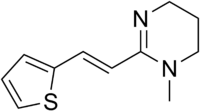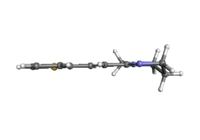Pyrantel
 | |
 | |
| Names | |
|---|---|
| IUPAC name
1-Methyl-2-[(E)-2-(2-thienyl)vinyl]-5,6-dihydro-4H-pyrimidine | |
| Identifiers | |
| ATC code | P02 QP52AF02 |
| 15686-83-6 | |
| ChEBI | CHEBI:8654 |
| ChEMBL | ChEMBL1626223 |
| Jmol-3D images | Image |
| KEGG | D08451 |
| MeSH | Pyrantel |
| PubChem | 708857 |
| |
| Properties | |
| C11H14N2S | |
| Molar mass | 206.31 g/mol |
| Except where noted otherwise, data is given for materials in their standard state (at 25 °C (77 °F), 100 kPa) | |
| | |
| Infobox references | |
Pyrantel is an antinematodal thiophene. It is often prescribed by veterinarians to treat and prevent the occurrence of intestinal parasites in small animal pets.
It is on the World Health Organization's List of Essential Medicines, a list of the most important medication needed in a basic health system.[1]
Mechanism of action
Pyrantel is a nicotinic receptor agonist.[2][3] Like levamisole and the related pyrimidine morantel, it can elicit spastic muscle paralysis in parasitic worms due to prolonged activation of the excitatory nicotinic acetylcholine (nACh) receptors on body wall muscle. This has been studied in body wall muscle preparation of the parasitic nematode Ascaris.[4]
See also
References
- ↑ "WHO Model List of EssentialMedicines" (PDF). World Health Organization. October 2013. Retrieved 22 April 2014.
- ↑ Aceves, J., Erlij, D., and Martinez-Maranon, R. (1970). The mechanism of the paralysing action of tetramisole on Ascaris somatic muscle. Br. J. Pharmacol. 38, 602–607.
- ↑ Aubry, M.L., Cowell, P., Davey, M.J., and Shevde, S. (1970). Aspects of the pharmacology of a new anthelmintic: pyrantel. Br. J. Pharmacol. 38, 332–344.
- ↑ Martin, R.J., Verma, S., Levandoski, M., Clark, C.L., Qian, H., Stewart, M., and Robertson, A.P. (2005). Drug resistance and neurotransmitter receptors of nematodes: recent studies on the mode of action of levamisole. Parasitology 131, S71–S84.
| ||||||||||||||||||||||||||||||||||||||||||||||||||||||||||||||||